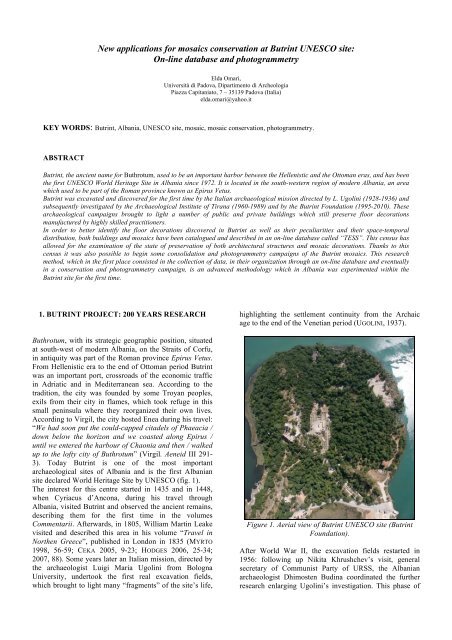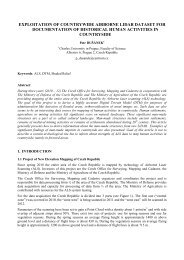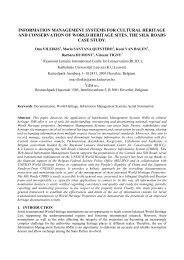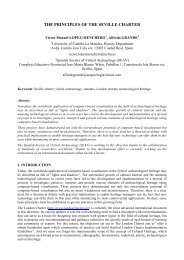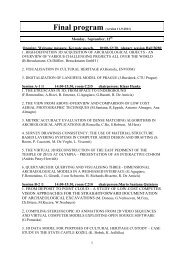New applications for the conservation of the mosaics at the ... - CIPA
New applications for the conservation of the mosaics at the ... - CIPA
New applications for the conservation of the mosaics at the ... - CIPA
You also want an ePaper? Increase the reach of your titles
YUMPU automatically turns print PDFs into web optimized ePapers that Google loves.
<strong>New</strong> <strong>applic<strong>at</strong>ions</strong> <strong>for</strong> <strong>mosaics</strong> <strong>conserv<strong>at</strong>ion</strong> <strong>at</strong> Butrint UNESCO site:On-line d<strong>at</strong>abase and photogrammetryElda Omari,Università di Padova, Dipartimento di ArcheologiaPiazza Capitani<strong>at</strong>o, 7 – 35139 Padova (Italia)elda.omari@yahoo.itKEY WORDS: Butrint, Albania, UNESCO site, mosaic, mosaic <strong>conserv<strong>at</strong>ion</strong>, photogrammetry.ABSTRACTButrint, <strong>the</strong> ancient name <strong>for</strong> Buthrotum, used to be an important harbor between <strong>the</strong> Hellenistic and <strong>the</strong> Ottoman eras, and has been<strong>the</strong> first UNESCO World Heritage Site in Albania since 1972. It is loc<strong>at</strong>ed in <strong>the</strong> south-western region <strong>of</strong> modern Albania, an areawhich used to be part <strong>of</strong> <strong>the</strong> Roman province known as Epirus Vetus.Butrint was excav<strong>at</strong>ed and discovered <strong>for</strong> <strong>the</strong> first time by <strong>the</strong> Italian archaeological mission directed by L. Ugolini (1928-1936) andsubsequently investig<strong>at</strong>ed by <strong>the</strong> Archaeological Institute <strong>of</strong> Tirana (1960-1989) and by <strong>the</strong> Butrint Found<strong>at</strong>ion (1995-2010). Thesearchaeological campaigns brought to light a number <strong>of</strong> public and priv<strong>at</strong>e buildings which still preserve floor decor<strong>at</strong>ionsmanufactured by highly skilled practitioners.In order to better identify <strong>the</strong> floor decor<strong>at</strong>ions discovered in Butrint as well as <strong>the</strong>ir peculiarities and <strong>the</strong>ir space-temporaldistribution, both buildings and <strong>mosaics</strong> have been c<strong>at</strong>alogued and described in an on-line d<strong>at</strong>abase called “TESS”. This census hasallowed <strong>for</strong> <strong>the</strong> examin<strong>at</strong>ion <strong>of</strong> <strong>the</strong> st<strong>at</strong>e <strong>of</strong> preserv<strong>at</strong>ion <strong>of</strong> both architectural structures and mosaic decor<strong>at</strong>ions. Thanks to thiscensus it was also possible to begin some consolid<strong>at</strong>ion and photogrammetry campaigns <strong>of</strong> <strong>the</strong> Butrint <strong>mosaics</strong>. This researchmethod, which in <strong>the</strong> first place consisted in <strong>the</strong> collection <strong>of</strong> d<strong>at</strong>a, in <strong>the</strong>ir organiz<strong>at</strong>ion through an on-line d<strong>at</strong>abase and eventuallyin a <strong>conserv<strong>at</strong>ion</strong> and photogrammetry campaign, is an advanced methodology which in Albania was experimented within <strong>the</strong>Butrint site <strong>for</strong> <strong>the</strong> first time.1. BUTRINT PROJECT: 200 YEARS RESEARCHButhrotum, with its str<strong>at</strong>egic geographic position, situ<strong>at</strong>ed<strong>at</strong> south-west <strong>of</strong> modern Albania, on <strong>the</strong> Straits <strong>of</strong> Corfu,in antiquity was part <strong>of</strong> <strong>the</strong> Roman province Epirus Vetus.From Hellenistic era to <strong>the</strong> end <strong>of</strong> Ottoman period Butrintwas an important port, crossroads <strong>of</strong> <strong>the</strong> economic trafficin Adri<strong>at</strong>ic and in Mediterranean sea. According to <strong>the</strong>tradition, <strong>the</strong> city was founded by some Troyan peoples,exils from <strong>the</strong>ir city in flames, which took refuge in thissmall peninsula where <strong>the</strong>y reorganized <strong>the</strong>ir own lives.According to Virgil, <strong>the</strong> city hosted Enea during his travel:“We had soon put <strong>the</strong> could-capped citadels <strong>of</strong> Phaeacia /down below <strong>the</strong> horizon and we coasted along Epirus /until we entered <strong>the</strong> harbour <strong>of</strong> Chaonia and <strong>the</strong>n / walkedup to <strong>the</strong> l<strong>of</strong>ty city <strong>of</strong> Buthrotum” (Virgil. Aeneid III 291-3). Today Butrint is one <strong>of</strong> <strong>the</strong> most importantarchaeological sites <strong>of</strong> Albania and is <strong>the</strong> first Albaniansite declared World Heritage Site by UNESCO (fig. 1).The interest <strong>for</strong> this centre started in 1435 and in 1448,when Cyriacus d’Ancona, during his travel throughAlbania, visited Butrint and observed <strong>the</strong> ancient remains,describing <strong>the</strong>m <strong>for</strong> <strong>the</strong> first time in <strong>the</strong> volumesCommentarii. Afterwards, in 1805, William Martin Leakevisited and described this area in his volume “Travel inNor<strong>the</strong>n Greece”, published in London in 1835 (MYRTO1998, 56-59; CEKA 2005, 9-23; HODGES 2006, 25-34;2007, 88). Some years l<strong>at</strong>er an Italian mission, directed by<strong>the</strong> archaeologist Luigi Maria Ugolini from BolognaUniversity, undertook <strong>the</strong> first real excav<strong>at</strong>ion fields,which brought to light many “fragments” <strong>of</strong> <strong>the</strong> site’s life,highlighting <strong>the</strong> settlement continuity from <strong>the</strong> Archaicage to <strong>the</strong> end <strong>of</strong> <strong>the</strong> Venetian period (UGOLINI, 1937).Figure 1. Aerial view <strong>of</strong> Butrint UNESCO site (ButrintFound<strong>at</strong>ion).After World War II, <strong>the</strong> excav<strong>at</strong>ion fields restarted in1956: following up Nikita Khrushchev’s visit, generalsecretary <strong>of</strong> Communist Party <strong>of</strong> URSS, <strong>the</strong> Albanianarchaeologist Dhimosten Budina coordin<strong>at</strong>ed <strong>the</strong> fur<strong>the</strong>rresearch enlarging Ugolini’s investig<strong>at</strong>ion. This phase <strong>of</strong>
works in Butrint lasted <strong>for</strong> about <strong>for</strong>ty years, during which<strong>the</strong> team was digging in <strong>the</strong> main Agora area, on <strong>the</strong>Acropolis and just sporadically somewhere else. Theexcav<strong>at</strong>ions reports are published, mainly in asummarizing way, in <strong>the</strong> archaeological Albanian review“Iliria”.Figure 2. Marked walks in <strong>the</strong> Butrint N<strong>at</strong>ional Park: 1Butrint; 3 Vrina; 6 Diaporit (plane by ButrintFound<strong>at</strong>ion).The archaeological research started again in 1994 andcurrently goes on thanks to <strong>the</strong> cooper<strong>at</strong>ion betweenButrint Found<strong>at</strong>ion and <strong>the</strong> Archaeological Park <strong>of</strong> Butrint,which go on with <strong>the</strong> excav<strong>at</strong>ions not limited only to <strong>the</strong>centre <strong>of</strong> Butrint, but bordering <strong>the</strong>ir action radius on <strong>the</strong>neighbouring area, in Vrina Plane and Diaporit (fig. 2).The research brought to light new public and priv<strong>at</strong>ebuildings decor<strong>at</strong>ed with <strong>mosaics</strong>, which <strong>of</strong>fered not onlyvaluable comparisons, but also new interpret<strong>at</strong>ions <strong>for</strong> <strong>the</strong>comprehension <strong>of</strong> <strong>the</strong> life and <strong>the</strong> culture inside andoutside <strong>of</strong> <strong>the</strong> walls <strong>of</strong> <strong>the</strong> city from Roman to L<strong>at</strong>eAntiquity Age.It must also be said th<strong>at</strong> <strong>the</strong> excav<strong>at</strong>ions fields <strong>of</strong> ButrintFound<strong>at</strong>ion have a fur<strong>the</strong>r aim: <strong>the</strong> training <strong>of</strong> students, <strong>the</strong>future archaeologists and conserv<strong>at</strong>ors <strong>of</strong> Albania, withscientific st<strong>at</strong>e <strong>of</strong> <strong>the</strong> art <strong>of</strong> methodologies (fig. 3).Figure 3. Conserv<strong>at</strong>ion training <strong>of</strong> students during <strong>the</strong>restaur<strong>at</strong>ion <strong>of</strong> a mosaic in Vrina Plane (photo by JackNeguer).For this reason, during <strong>the</strong> excav<strong>at</strong>ion missions, spans <strong>of</strong>time are scheduled <strong>for</strong> training about excav<strong>at</strong>ion andrestor<strong>at</strong>ion with teams <strong>of</strong> experts, in order to upd<strong>at</strong>estudents with new techniques and methodologies <strong>for</strong>mosaic restor<strong>at</strong>ion.There<strong>for</strong>e, this paper will present <strong>the</strong> methodology <strong>of</strong> <strong>the</strong>work undertaken, taking into account <strong>the</strong> tw<strong>of</strong>old soul,didactic and scientific, and following <strong>the</strong> words <strong>of</strong> JacquesNeguer, from <strong>the</strong> Israel Antiquities Authority: “Theexcav<strong>at</strong>ion provides a good opportunity <strong>for</strong> training andshort team courses can be given during <strong>the</strong> excav<strong>at</strong>ionseason. One part <strong>of</strong> <strong>the</strong> Albanian students can be involvedin <strong>conserv<strong>at</strong>ion</strong> works. The students in archaeology shouldhave basic knowledge in <strong>conserv<strong>at</strong>ion</strong>. The o<strong>the</strong>r way is toset up a long team <strong>conserv<strong>at</strong>ion</strong> project <strong>at</strong> Butrint and in<strong>the</strong> frame <strong>of</strong> this project to provide <strong>the</strong> necessary training<strong>for</strong> <strong>the</strong> Albanian <strong>conserv<strong>at</strong>ion</strong>, site rangers andcustodians. The site can be <strong>the</strong> future educ<strong>at</strong>ion center <strong>for</strong><strong>the</strong> whole country and in <strong>the</strong> summer to expandintern<strong>at</strong>ionally with short team courses <strong>for</strong> students andarchaeologists” (NEGUER 2006, 35).The new technology <strong>applic<strong>at</strong>ions</strong> to <strong>the</strong> study and <strong>the</strong><strong>conserv<strong>at</strong>ion</strong> <strong>of</strong> <strong>the</strong> archaeological evidence represent one<strong>of</strong> <strong>the</strong> guideline <strong>of</strong> “Butrint Project”. The proposalinnov<strong>at</strong>ion consists <strong>of</strong> integr<strong>at</strong>ing <strong>the</strong> in<strong>for</strong>m<strong>at</strong>iveeffectiveness both <strong>of</strong> on-line d<strong>at</strong>abases andphotogrammetry document<strong>at</strong>ion, with <strong>the</strong> potentialityscientific and communic<strong>at</strong>ive <strong>of</strong> <strong>the</strong> virtual reconstructionconducted with philological criteria, finalized not only to<strong>the</strong> research, but also to <strong>the</strong> site fruition.Wh<strong>at</strong> is presented in <strong>the</strong> following pages is <strong>the</strong> fruit <strong>of</strong> <strong>the</strong>cooper<strong>at</strong>ion among <strong>the</strong> Butrint Found<strong>at</strong>ion, <strong>the</strong>Archaeological Park <strong>of</strong> Butrint, <strong>the</strong> ArchaeologicalInstitute and <strong>the</strong> Culture Monuments in Tirana, IsraelAntiquities Authority and Archaeology Department <strong>of</strong>University <strong>of</strong> Padua. As you can see from <strong>the</strong> list <strong>of</strong>participants, <strong>the</strong> energies spent on <strong>the</strong> field have beenconspicuous, as well as time-consuming: five years <strong>of</strong>work to reach <strong>the</strong> expected results th<strong>at</strong> speak <strong>of</strong> vastknowledge, <strong>conserv<strong>at</strong>ion</strong> and valoris<strong>at</strong>ion <strong>of</strong> <strong>mosaics</strong>.2. TESS PROJECTToday, in <strong>the</strong> internet era, all is computerized and visibleon line, almost everything is c<strong>at</strong>alogued and usable byeverybody, o<strong>the</strong>r than be in constant upd<strong>at</strong>ing.Also archaeology is moving in this direction: digitizedresearches and sometimes, where possible, rebuilt in 3Drooms, buildings, cities and landscape existed in past ages,founded on scientific d<strong>at</strong>a provided by archaeologicalexcav<strong>at</strong>ion. This is possible thanks to new s<strong>of</strong>tware whichis always in evolution and thanks to n<strong>at</strong>ional andintern<strong>at</strong>ional workshops in which <strong>the</strong> researchers present<strong>the</strong>ir projects and <strong>the</strong> results obtained, exchange ideas andcompare <strong>the</strong>ir own experiences.In this point <strong>of</strong> view, <strong>for</strong> ten years, a team from <strong>the</strong>Archaeological Department <strong>of</strong> University <strong>of</strong> Padua,coordin<strong>at</strong>ed by Pr<strong>of</strong>. Elena Francesca Ghedini, has devotedspecial <strong>at</strong>tention to <strong>the</strong> prospective <strong>of</strong> in<strong>for</strong>m<strong>at</strong>ics appliedto archaeology and to <strong>the</strong> valoris<strong>at</strong>ion <strong>of</strong> <strong>the</strong> archaeologicalfindings as a method <strong>of</strong> work and study helpful toresearch. For <strong>the</strong> study, <strong>the</strong> <strong>conserv<strong>at</strong>ion</strong> and <strong>the</strong> heritage<strong>of</strong> <strong>the</strong> <strong>mosaics</strong> an on-line d<strong>at</strong>abase called “TESS” (inFileMaker Pro 9) was built. This d<strong>at</strong>abase was conceivedas a hierarchical structure which allows <strong>for</strong> <strong>the</strong> insertion <strong>of</strong>d<strong>at</strong>a entries about <strong>the</strong> finds. Their analysis starts from <strong>the</strong>general level and moves on to a more specific level andfrom <strong>the</strong> external to <strong>the</strong> internal level. This way <strong>of</strong>
conceiving <strong>the</strong> d<strong>at</strong>abase starts from <strong>the</strong> description <strong>of</strong> <strong>the</strong>building and moves on to th<strong>at</strong> <strong>of</strong> <strong>the</strong> room, followed by <strong>the</strong>floor decor<strong>at</strong>ions and eventually to an exhaustivepresent<strong>at</strong>ion <strong>of</strong> <strong>the</strong> models th<strong>at</strong> compose <strong>the</strong> mosaic. Thissystem <strong>of</strong> study, based upon an organiz<strong>at</strong>ion <strong>of</strong> <strong>the</strong>in<strong>for</strong>m<strong>at</strong>ion in different levels or str<strong>at</strong>a, also introducesinnov<strong>at</strong>ion in this type <strong>of</strong> research, since it highlights <strong>the</strong>architectural contexts which contain <strong>the</strong> floor decor<strong>at</strong>ions(GHEDINI et al. 2007; OMARI 2009; OMARI <strong>for</strong>thcoming).At <strong>the</strong> first level <strong>of</strong> <strong>the</strong> d<strong>at</strong>a entry field a page called“building” appears, which is about <strong>the</strong> loc<strong>at</strong>ion <strong>of</strong> <strong>the</strong>structure (Country, District, City, Village and address) and<strong>the</strong> typological description <strong>of</strong> <strong>the</strong> architectural context (e.g.priv<strong>at</strong>e, public, <strong>the</strong>rmal b<strong>at</strong>h, temple, basilica). On this page,<strong>the</strong> map <strong>of</strong> <strong>the</strong> area can be linked in <strong>the</strong> field called “mapbuilding place”, thanks to a direct link to Google maps. Also<strong>the</strong> drawing <strong>of</strong> <strong>the</strong> building, if available, can be inserted into<strong>the</strong> “building plan” field (fig. 4).At <strong>the</strong> same level, on a second page called “room”, <strong>the</strong>in<strong>for</strong>m<strong>at</strong>ion about a decor<strong>at</strong>ed room can be inserted, startingfrom <strong>the</strong> description <strong>of</strong> <strong>the</strong> typology <strong>of</strong> room (peristyle,represent<strong>at</strong>ive room, triclinium, pronaos, naos, aula, <strong>the</strong>rmalroom, tepidarium, nar<strong>the</strong>x, nave, etc.), followed by itsmeasures and description. Also here, like on <strong>the</strong> page be<strong>for</strong>e,a part <strong>of</strong> <strong>the</strong> slide is devoted to <strong>the</strong> on-line public<strong>at</strong>ion <strong>of</strong> <strong>the</strong>plan <strong>of</strong> <strong>the</strong> room. It must be pointed out th<strong>at</strong> <strong>at</strong> <strong>the</strong> bottom <strong>of</strong>both pages, <strong>the</strong> one about <strong>the</strong> building and <strong>the</strong> one about <strong>the</strong>room, <strong>the</strong>re is a field labelled “chronology” which allows <strong>for</strong><strong>the</strong> insertion <strong>of</strong> <strong>the</strong> d<strong>at</strong>ing with <strong>the</strong> archaeological criterionadopted by <strong>the</strong> archaeologist <strong>for</strong> its definition(archaeological, stylistic-archaeological, etc.). In this way<strong>the</strong> first chronological reference is established which will beresumed on <strong>the</strong> page about <strong>the</strong> textures <strong>of</strong> <strong>the</strong> decor<strong>at</strong>ions,and which is useful to trace and compare <strong>the</strong> various phases<strong>of</strong> use <strong>of</strong> <strong>the</strong> structure and <strong>of</strong> <strong>the</strong> decor<strong>at</strong>ions <strong>the</strong>y contain.At <strong>the</strong> second level, <strong>the</strong> two pages “covering floor” and“texture decor<strong>at</strong>ion” are devoted to <strong>the</strong> description <strong>of</strong> <strong>the</strong>cover floor which decor<strong>at</strong>es <strong>the</strong> pavement (fig. 5).Figure 4: D<strong>at</strong>abase TESS-building slide.On <strong>the</strong> “covering” page it is possible to be specific about<strong>the</strong> texture <strong>of</strong> <strong>the</strong> decor<strong>at</strong>ions <strong>of</strong> <strong>the</strong> floors. They can bewith single cover or with multiple covers, th<strong>at</strong> is, <strong>the</strong> floorscan fe<strong>at</strong>ure a single decor<strong>at</strong>ion or multiple decor<strong>at</strong>ions.The description <strong>of</strong> all pavement surfaces, general andsyn<strong>the</strong>tic, is accompanied by <strong>the</strong> images <strong>of</strong> <strong>the</strong> floordecor<strong>at</strong>ion, which is useful not only to better understand<strong>the</strong> decor<strong>at</strong>ion, but also to provide a complete overview.This page is <strong>the</strong> last one but not in terms <strong>of</strong> importance.On this page we find in<strong>for</strong>m<strong>at</strong>ion about how to install <strong>the</strong>mosaic and about how to conduct <strong>the</strong> labor<strong>at</strong>ory analyses<strong>of</strong> <strong>the</strong> m<strong>at</strong>erials used to build <strong>the</strong> pavement.Besides <strong>the</strong> in<strong>for</strong>m<strong>at</strong>ion described above, in <strong>the</strong> fielddevoted to <strong>the</strong> “covering” it is possible to give a morecomplete and upd<strong>at</strong>ed overview <strong>of</strong> <strong>the</strong> floor decor<strong>at</strong>ion.Inside this field <strong>the</strong>re is a field devoted to <strong>the</strong> inscriptionwhich allows <strong>for</strong> <strong>the</strong> insertion <strong>of</strong> <strong>the</strong> transcription, <strong>the</strong>transl<strong>at</strong>ion, <strong>the</strong> measures, <strong>the</strong> language (Greek or L<strong>at</strong>in) <strong>of</strong><strong>the</strong> inscription or <strong>the</strong> monogram/Christogram present on<strong>the</strong> cover floor.Figure 5: D<strong>at</strong>abase TESS-floor decor<strong>at</strong>ion slide.On <strong>the</strong> following page, which is devoted to <strong>the</strong> texture <strong>of</strong><strong>the</strong> mosaic surface, <strong>the</strong> decor<strong>at</strong>ion can be described indetail by means <strong>of</strong> specific terms. Here every componentwhich <strong>for</strong>ms <strong>the</strong> floor decor<strong>at</strong>ion is dismembered, in orderto single out its basis p<strong>at</strong>tern. Starting from <strong>the</strong> external to<strong>the</strong> internal part <strong>of</strong> floor decor<strong>at</strong>ion we will distinguish: <strong>the</strong>band connection, th<strong>at</strong> is, <strong>the</strong> most external part in <strong>the</strong>mosaic which fills <strong>the</strong> gap between <strong>the</strong> borders <strong>of</strong> <strong>the</strong>mosaic and <strong>the</strong> walls when <strong>the</strong> measure <strong>of</strong> <strong>the</strong> room arenot regular; <strong>the</strong> border, which limits both <strong>the</strong> field and <strong>the</strong>possible panels or <strong>the</strong> emblem/pseudo-emblem whichmakes up <strong>the</strong> cover floor; <strong>the</strong> field which corresponds to<strong>the</strong> mosaic without <strong>the</strong> border. The breakdown <strong>of</strong> <strong>the</strong> partswhich make up <strong>the</strong> cover floor does not only allow <strong>for</strong> adetailed description <strong>of</strong> each decor<strong>at</strong>ive component and <strong>for</strong><strong>the</strong> specific<strong>at</strong>ion <strong>of</strong> <strong>the</strong> single motives used <strong>for</strong> <strong>the</strong> bordersand <strong>the</strong> fields. It also gives one <strong>the</strong> opportunity tounderstand which p<strong>at</strong>terns are required <strong>the</strong> most by localpurchasers. In order to identify which <strong>of</strong> <strong>the</strong> geometricalp<strong>at</strong>terns are used in <strong>the</strong> <strong>mosaics</strong> decor<strong>at</strong>ions, <strong>the</strong> chosenparameters <strong>of</strong> reference are those established by <strong>the</strong>volumes “Décore géométrique” edited by <strong>the</strong> FrenchSchool (BALMELLE et al 1985; BALMELLE et al 2002). Inorder to better manage <strong>the</strong> quantity <strong>of</strong> in<strong>for</strong>m<strong>at</strong>ion, <strong>the</strong>d<strong>at</strong>abase is supported by three external archives which areconnected to <strong>the</strong> computer system. These three archivesmake reference to <strong>the</strong> bibliography, <strong>the</strong> “Décorgéométrique” p<strong>at</strong>tern and to <strong>the</strong> <strong>conserv<strong>at</strong>ion</strong> areas.To sum it up, we can say th<strong>at</strong> <strong>the</strong> research is based on acollection in a d<strong>at</strong>abase <strong>of</strong> all <strong>the</strong> in<strong>for</strong>m<strong>at</strong>ion about <strong>the</strong>cover floor. It brings toge<strong>the</strong>r <strong>the</strong> terminology and makes itpossible to cre<strong>at</strong>e typological grids <strong>for</strong> <strong>the</strong> identific<strong>at</strong>ion <strong>of</strong><strong>the</strong> rel<strong>at</strong>ed texture, decor<strong>at</strong>ions, colours, as well as <strong>the</strong>characteriz<strong>at</strong>ion <strong>of</strong> <strong>the</strong> type <strong>of</strong> <strong>the</strong> floor. After <strong>the</strong> criticalanalysis <strong>of</strong> <strong>the</strong> d<strong>at</strong>a, <strong>the</strong>se elements briefly explain <strong>the</strong>specific taste <strong>of</strong> <strong>the</strong> people in <strong>the</strong> investig<strong>at</strong>ed area.The d<strong>at</strong>a collection <strong>of</strong> <strong>the</strong> <strong>mosaics</strong> found in Butrint showsth<strong>at</strong> to d<strong>at</strong>e eighteen <strong>mosaics</strong> have been discovered, whichdecor<strong>at</strong>ed rooms <strong>of</strong> priv<strong>at</strong>e and public buildings,
predominantly in three colours and with many colours withgeometrical and geometrical-figur<strong>at</strong>ive p<strong>at</strong>terns. TheButrint <strong>mosaics</strong> belong to a chronologic range from <strong>the</strong>2nd century to <strong>the</strong> 6th century A.D. (OMARI 2009; OMARI<strong>for</strong>thcoming).3. PHOTOGRAMMETRY APPLICATIONS ON THEMOSAICS OF BUTRINTwith an increasing number; this procedure is necessary <strong>for</strong>cre<strong>at</strong>ing a network which will build <strong>the</strong> archives <strong>of</strong> <strong>the</strong>points and <strong>of</strong> <strong>the</strong> images (fig. 7). For realizing <strong>the</strong> photographic campaign asimple digital camera is used, which is guided by remotecontrol with infrared; <strong>the</strong> camera is fixed on top <strong>of</strong> a steelstick, around 2.5 metres long (fig. 8).In Butrint, <strong>for</strong> <strong>the</strong> first time in Albania, <strong>the</strong> planningactivities also favoured <strong>the</strong> technological transference <strong>of</strong><strong>the</strong> most advanced studies in this sector <strong>of</strong> CulturalHeritage fruition, rel<strong>at</strong>ed to 3D Graphic, Virtual Reality,GIS, Semantic Web, etc.For documenting and better preserving wh<strong>at</strong> wasexcav<strong>at</strong>ed be<strong>for</strong>e <strong>the</strong> last researches took place, <strong>the</strong> ButrintFound<strong>at</strong>ion in cooper<strong>at</strong>ion with Massimo Zanfini from <strong>the</strong>Bologna University, has begun a rash <strong>of</strong> photogrammetricfields carried over on some mosaic floors and to be moreprecise on <strong>the</strong> <strong>mosaics</strong> <strong>of</strong> Triconch palace, on Baptistry<strong>mosaics</strong>, on <strong>mosaics</strong> found in Vrina Plave basilica andvilla since 2005. To d<strong>at</strong>e twelve <strong>mosaics</strong> are documentedby photogrammetry relief.The methodology <strong>of</strong> photogrammetric document<strong>at</strong>ion iscarried out in <strong>the</strong> following steps in a precise hierarchy: The first step to do when undertaking aphotogrammetric campaign consists <strong>of</strong> a meticulouscleaning <strong>of</strong> <strong>the</strong> mosaic surfaces (fig. 6), followed bycareful examin<strong>at</strong>ion <strong>of</strong> <strong>the</strong> area <strong>of</strong> interest; thisprocedure will allow selecting –with full knowledge <strong>of</strong> <strong>the</strong>facts– whe<strong>the</strong>r taking photographs from a low-flying kiteand/or making <strong>the</strong> photogrammetry by a camera positionedon top <strong>of</strong> a pole around two meters high.Figure 7. The grid points <strong>of</strong> <strong>the</strong> archives made during <strong>the</strong>photography (Zanfini 2003, 261, fig.1, revised by. E.Omari).Following <strong>the</strong> way <strong>of</strong> <strong>the</strong> sun, particular <strong>at</strong>tention must bepayed to <strong>the</strong> moment when pictures need to be taken inorder to avoid <strong>the</strong> shadow zone as much as possible, since<strong>the</strong> n<strong>at</strong>ural conditions <strong>of</strong> <strong>the</strong> sun light are, obviously, <strong>the</strong>best ones. In order to show <strong>the</strong> colours <strong>of</strong> <strong>the</strong> tesserae in amore faithful way, be<strong>for</strong>e taking <strong>the</strong> picture, <strong>the</strong> part <strong>of</strong>mosaic selected <strong>for</strong> <strong>the</strong> picture is washed up with a w<strong>at</strong>erpump or with a simple sponge. At <strong>the</strong> same time eachpicture is checked in order to ensure th<strong>at</strong> in every picture<strong>at</strong> least four points are present. Each picture is <strong>at</strong>tributedwith a number or an identific<strong>at</strong>ion code which will betransferred into <strong>the</strong> network <strong>of</strong> points. This work leads usto <strong>the</strong> cre<strong>at</strong>ion <strong>of</strong> two archives: one <strong>for</strong> <strong>the</strong> pictures andone <strong>for</strong> <strong>the</strong> points rel<strong>at</strong>ed to <strong>the</strong> picture (ZANFINI,VECCHIETTI 2004, 849-856).Figure 6. The cleaning <strong>of</strong> <strong>the</strong> mosaic floor (photo byButrint Found<strong>at</strong>ion). Once <strong>the</strong> st<strong>at</strong>e <strong>of</strong> preserv<strong>at</strong>ion <strong>of</strong> <strong>the</strong> mosaic and<strong>the</strong> best conditions <strong>for</strong> taking <strong>the</strong> photogrammetry havebeen decided, points on <strong>the</strong> mosaic are chosen and <strong>the</strong>nrecognized through <strong>the</strong> total st<strong>at</strong>ion. It is important th<strong>at</strong><strong>the</strong>se points are visible in <strong>the</strong> picture; indeed thanks to<strong>the</strong>se points <strong>the</strong> assembling <strong>of</strong> <strong>the</strong> pictures will be evidenton <strong>the</strong> computer <strong>for</strong> recomposing <strong>the</strong> full mosaicdecor<strong>at</strong>ion in detail.The network positioning ensures with gre<strong>at</strong>er security th<strong>at</strong><strong>at</strong> least four points are present in each picture. The pointsneed to be recorded by total st<strong>at</strong>ion and brought toge<strong>the</strong>rFigure 8. Photogrammetry <strong>of</strong> <strong>the</strong> mosaic floor in TiconchPalace <strong>at</strong> Butrint (photo by Jacques Neguer). Once <strong>the</strong> pictures are obtained, <strong>the</strong>y are processedfollowing <strong>the</strong> process <strong>of</strong> chrom<strong>at</strong>ic gradu<strong>at</strong>ion,rectific<strong>at</strong>ion and assemblage, juxtaposing all <strong>the</strong> picturesfollowing <strong>the</strong> network prepared in advance and reunifying
<strong>the</strong> chrom<strong>at</strong>ic gradu<strong>at</strong>ed to assemble <strong>the</strong> different photos toone single image. All <strong>the</strong> work is done using <strong>the</strong> computerprogram Adobe Photoshop: in our case we used <strong>the</strong>version Adobe Photoshop 7.0. The goal is to cre<strong>at</strong>e a planphoto in high definition, in which every single tessera isvisible, to control <strong>the</strong> gaps <strong>of</strong> <strong>the</strong> mosaic, as well as to see<strong>the</strong> drawing in detail (fig. 9). A very important aspect <strong>of</strong> <strong>the</strong> fruition <strong>of</strong>archaeological d<strong>at</strong>a, <strong>at</strong> scientific and popular levels, is <strong>the</strong>panoramic photography. It consists <strong>of</strong> an “interactive”process, in which <strong>the</strong> user can scout <strong>the</strong> object (e.g. amosaic, but also a room), by 360 degrees, moving <strong>the</strong>mouse. Thanks to <strong>the</strong> program QTVR (Quick Time VirtualReality) it is also possible to activ<strong>at</strong>e zoom in and zoomout, <strong>for</strong> entering and seeing <strong>the</strong> artefact in detail. Thesefiles, available on <strong>the</strong> web, allow exploring <strong>the</strong> differentrooms from a fixed position with a corner view <strong>of</strong> 360°,thus enabling <strong>the</strong> user to feel as he was in <strong>the</strong> middle <strong>of</strong> <strong>the</strong>building and immersed in it. (ZANFINI 2003, 259-266).Figure 9. QTVR present<strong>at</strong>ion <strong>of</strong> <strong>the</strong> mosaic floor <strong>of</strong>Baptisery (http://www.butrint.org/explore_9_4.php, madeby Butrint Found<strong>at</strong>ion).In Butrint, a good example is <strong>the</strong> applic<strong>at</strong>ion <strong>of</strong> QTVR <strong>for</strong><strong>the</strong> virtual explor<strong>at</strong>ion <strong>of</strong> <strong>the</strong> building <strong>of</strong> Baptistery, aswell as <strong>for</strong> an exhaustive view <strong>of</strong> <strong>the</strong> mosaic decor<strong>at</strong>ion.Today it is possible to access <strong>the</strong>se views on <strong>the</strong> website <strong>of</strong>Butrint. Such a work enhances <strong>the</strong> "virtual" present<strong>at</strong>ion <strong>of</strong><strong>the</strong> ancient building as it is preserved just as <strong>the</strong> mosaicwhich, supplied by a scientific text, will allow a correctand thorough limitless knowledge; by <strong>the</strong>se means newintern<strong>at</strong>ional pr<strong>of</strong>essional cooper<strong>at</strong>ion also can startexamining <strong>the</strong> d<strong>at</strong>a.At <strong>the</strong> same time using <strong>the</strong> above-mentioned programssome <strong>mosaics</strong> underwent also some restor<strong>at</strong>ion campaigns,which are still ongoing. The last restor<strong>at</strong>ions have brought<strong>the</strong> researchers to study <strong>the</strong> situ<strong>at</strong>ion <strong>of</strong> <strong>the</strong> prepar<strong>at</strong>ionlevels <strong>of</strong> <strong>the</strong> <strong>mosaics</strong> and <strong>the</strong> consolid<strong>at</strong>ion <strong>of</strong> <strong>the</strong>irdamaged parts. Since <strong>the</strong>se artworks are now situ<strong>at</strong>ed inancient buildings, not provided anymore with a ceiling,<strong>the</strong>y are covered with sand and gravel in order to beprotected from bad wea<strong>the</strong>r and corrosion <strong>of</strong> saltw<strong>at</strong>erinfiltr<strong>at</strong>ions from <strong>the</strong> Vivari Channel and Butrint Lake: awell-known problem to Ugolini, during his excav<strong>at</strong>ionsperiod. (NEGUER 2006; 2007a; 2007b).4. CONCLUSIONSThe d<strong>at</strong>a collection into <strong>the</strong> on-line d<strong>at</strong>abase “TESS” and<strong>the</strong> study <strong>of</strong> <strong>the</strong> floor decor<strong>at</strong>ions in Butrint helped us tocomprehend <strong>the</strong> topographic distribution <strong>of</strong> this ancientcity, <strong>the</strong> taste <strong>of</strong> <strong>the</strong> area and <strong>the</strong> selections made by <strong>the</strong>purchasers about <strong>the</strong> decor<strong>at</strong>ive p<strong>at</strong>terns to be representedin <strong>the</strong>ir <strong>mosaics</strong>, <strong>the</strong> abilities <strong>of</strong> <strong>the</strong> artisans to make <strong>the</strong><strong>mosaics</strong> and <strong>the</strong> connections with <strong>the</strong> neighbouring areas.In <strong>the</strong> end <strong>of</strong> this paper, to sum up wh<strong>at</strong> was explored, itbecomes clear th<strong>at</strong> <strong>the</strong> scientific program followed inButrint turns out to be an innov<strong>at</strong>ive program. For <strong>the</strong> firsttime, beside <strong>the</strong> archaeological excav<strong>at</strong>ions, <strong>the</strong> artwork –in our case <strong>the</strong> <strong>mosaics</strong> and <strong>the</strong> buildings which contain<strong>the</strong> decor<strong>at</strong>ion– are consolid<strong>at</strong>ed, c<strong>at</strong>alogued in an on-lined<strong>at</strong>abase, noted by photogrammetry rectific<strong>at</strong>ion, valorisedand publicized on-line.As already mentioned, <strong>the</strong> “TESS” d<strong>at</strong>abase allows <strong>the</strong>user in any time and from several points not only d<strong>at</strong>aentry and upd<strong>at</strong>ing a considerable number <strong>of</strong> d<strong>at</strong>a and <strong>of</strong>in<strong>for</strong>m<strong>at</strong>ion useful to <strong>the</strong> research, but also <strong>the</strong>consult<strong>at</strong>ion. In this way <strong>the</strong> d<strong>at</strong>abase facilit<strong>at</strong>es <strong>the</strong> d<strong>at</strong>aretrieval and <strong>the</strong>re<strong>for</strong>e <strong>the</strong> study and <strong>the</strong> knowledge <strong>of</strong> <strong>the</strong>territory, <strong>of</strong> <strong>the</strong> building, <strong>of</strong> <strong>the</strong> floor decor<strong>at</strong>ion, <strong>of</strong> <strong>the</strong>m<strong>at</strong>erial used and <strong>of</strong> <strong>the</strong> mosaic’s st<strong>at</strong>e <strong>of</strong> preserv<strong>at</strong>ion.The innov<strong>at</strong>ion proposed by <strong>the</strong> Butrint project consists incompleting <strong>the</strong> in<strong>for</strong>m<strong>at</strong>ive validity <strong>of</strong> <strong>the</strong> photogrammetrydocument<strong>at</strong>ion with <strong>the</strong> scientific potential andcommunic<strong>at</strong>ive power <strong>of</strong> <strong>the</strong> virtual reconstruction ledwith philological criteria, finalized not only to research,but also <strong>for</strong> gaining knowledge.To conclude it must be said th<strong>at</strong> <strong>the</strong> use <strong>of</strong> <strong>the</strong> newtechnologies represents a surplus value upon which onemay aim <strong>for</strong> gener<strong>at</strong>ing interest and curiosity among <strong>the</strong>visitors towards <strong>the</strong> cultural roots <strong>of</strong> <strong>the</strong> territory, in orderto favour <strong>the</strong> circul<strong>at</strong>ion <strong>of</strong> <strong>the</strong> knowledge and to getbenefit on <strong>the</strong> development <strong>of</strong> <strong>the</strong> territory. All this ef<strong>for</strong>twill be vain if <strong>the</strong>se techniques and methodology were notcommunic<strong>at</strong>ed to <strong>the</strong> new gener<strong>at</strong>ions by means <strong>of</strong> fieldtraining and applic<strong>at</strong>ion <strong>of</strong> this procedure also in o<strong>the</strong>rAlbanian sites characterized by an archaeological andhistorical importance.For <strong>the</strong> future we wish th<strong>at</strong> <strong>the</strong> methodology shown herebecomes a guideline <strong>for</strong> future archaeological researches inAlbania, <strong>for</strong> <strong>the</strong>ir document<strong>at</strong>ion in view <strong>of</strong> <strong>the</strong> heritage<strong>conserv<strong>at</strong>ion</strong> and enhancement. (VOLPE 2008, 9-11).5. REFERENCESBALMELLE C. et al 1985. Le décor géométrique de lamosaïque romaine. Répertoire graphique et descriptif descompositions linéaires et isotropes, vol. I, Picard, Paris.BALMELLE C. et al 2002. Le décor géométrique de lamosaïque romaine. Répertoire graphique et descriptif descentrés, vol. II, Picard. Paris.BRUMANA R. et al 2005, Laser scanner integr<strong>at</strong>ed byphotogrammetry <strong>for</strong> reverse engineering to supportarchitectural site and restaur<strong>at</strong>ion <strong>of</strong> <strong>the</strong> mosaic floorinside St. Mark’s basilica in Venice, <strong>CIPA</strong> 2005 XXIntern<strong>at</strong>ional Symposium (Torino, 26 september – 1october 2005),
CATTANI M. 2008, Il percorso della conoscenza:applicazioni in archeologia tra ricerca e divulgazione,In<strong>for</strong>m<strong>at</strong>ica e il metodo della str<strong>at</strong>igrafia, Atti delWorkshop (Foggia, 6-7 giugno 2008), a cura di G. DeFelice, M.G. Sibilano, G. Volpe, Bari, pp. 25-37.CEKA N. 2005, Illirët, Tirana, 9-23.CLEMENTI T. 2004, I mosaici come fonte archeologica perlo studio dell’urbanistica. Il caso di Padova, Atti del IXColloquio dell’Associazione Italiana per lo Studio e laConservazione del Mosaico (Aosta, 20-22 febbraio 2003) acura di C. Angelelli, Ravenna, pp. 139-150.DE FELICE G. 2008, Il progetto Itinera. Ricerca ecomunicazione <strong>at</strong>traverso nuovi metodi di documentazionearcheologica, In<strong>for</strong>m<strong>at</strong>ica e il metodo della str<strong>at</strong>igrafia,Atti del Workshop (Foggia, 6-7 giugno 2008), a cura di G.De Felice, M.G. Sibilano, G. Volpe, Bari, pp. 13-24.GHEDINI E. et al 2007, La banca d<strong>at</strong>i on-line deirivestimenti a mosaico, Archeologia e Calcol<strong>at</strong>ori, 18, pp.13-43.HODGES R. 2006, Eternal Butrint. A Unesco WorldHeritage Site in Albania, London, General PennePublishing.HODGES R. 2007, Novità archeologiche da Butrinto.Duecento anni di ricerche a Butrinto, Paradigmi checambiano, Groma 1. Archeologia tra Piceno, Dalmazia edEpiro, Bologna.HODGES R., BOWDEN W., LAKO K. 2004, ByzantineButrint. Excav<strong>at</strong>ions and Surveys 1994-1999, Ox<strong>for</strong>d,Oxbow Books.MITCHELL J. 2008, The Butrint baptistery and ist mosiacs,London-Tirana, Butrint Found<strong>at</strong>ion.MYRTO H. 1998, Buthroton, Albania archeologica.Bibliografia sistem<strong>at</strong>ica dei centri antichi, Bari, 50-60.NEGUER J. 2006, Conserv<strong>at</strong>ion <strong>of</strong> <strong>mosaics</strong> <strong>at</strong> Butrint,Albania, Final report and recommend<strong>at</strong>ions, ButrintFound<strong>at</strong>ion and Israel Antiqiutes Athority Arcaivs, July2006, (unpublishd).NEGUER J. 2007a, Conserv<strong>at</strong>ion <strong>of</strong> <strong>mosaics</strong> <strong>at</strong> Butrint,Albania, Final report and recommend<strong>at</strong>ions, ButrintFound<strong>at</strong>ion and Israel Antiqiutes Athority Arcaivs, July2007, (unpublishd).NEGUER J. 2007b, Conserv<strong>at</strong>ion <strong>of</strong> <strong>mosaics</strong> <strong>at</strong> Butrint,Albania, The triconch domus. Condition report andrecommend<strong>at</strong>ions, Butrint Found<strong>at</strong>ion and IsraelAntiqiutes Athority Arcaivs, December 2007,(unpublishd).OMARI E. 2009, Storia e sviluppo dei rivestimentipavimentali nell’area sudoccidentale dei Balcani.L’Albania (fine del IV /inizio del III sec.a.C.-VI sec.d.C.),PhD dissert<strong>at</strong>ion, University <strong>of</strong> Padua, Padova,(unpublishd).PIETRONI E. 2008, Ambienti collabor<strong>at</strong>ivi ed ecosistemivirtuali per la trasmissione e comunicazione delp<strong>at</strong>rimonio culturale: il museo virtuale della via Flaminiaantica, In<strong>for</strong>m<strong>at</strong>ica e il metodo della str<strong>at</strong>igrafia, Atti delWorkshop (Foggia, 6-7 giugno 2008), a cura di G. DeFelice, M.G. Sibilano, G. Volpe, Bari, pp. 55-73.VOLPE G. 2008, “Pesare la digitalizzazione”.L’in<strong>for</strong>m<strong>at</strong>ica applic<strong>at</strong>a all’archeologia tra tecnologia emetodologia, In<strong>for</strong>m<strong>at</strong>ica e il metodo della str<strong>at</strong>igrafia,Atti del Workshop (Foggia, 6-7 giugno 2008), a cura di G.De Felice, M.G. Sibilano, G. Volpe, Bari, pp. 9-11.ZANFINI M. 2003, Il rilievo di un pavimento musivo sito diBir Messaouda, Cartagine, Ocnus. Quaderni della Scuoladi specializzazione in archeologia, nr. 11, Bologna, pp.259-266.ZANFINI M., VECCHIETTI E. 2004, Fotogrammetria evirtual reality. La casa del Centenario (IX, 8, 3.6.A) aPompei, Atti del IX Colloquio dell’Associazione Italianaper lo Studio e la Conservazione del Mosaico (Aosta, 20-22 febbraio 2003) a cura di C. Angelelli, Ravenna, pp.849-856.UGOLINI, L. M. 1937, Butrinto. Il mito di Enea, gli scavi,Istituto Italiano di Cultura, Tirana.Ut n<strong>at</strong>ura ars. Virtual Reality e archeologia, Atti dellaGiorn<strong>at</strong>a di Studi (Bologna, 22 aprile 2002), a cura di A.Coralini, D. Scagliarini Corlàita, Imola.6. WEBSITEShttp://www.butrintfound<strong>at</strong>ion.co.uk/http://www.butrint.org/http://www.perseo.lettere.unipd.it/tess/http://www.antiquities.org.il/ACKNOWLEDGEMENTSI would like to take advantage <strong>of</strong> this public<strong>at</strong>ion toexpress my most sincere gr<strong>at</strong>itude to <strong>the</strong> organizers <strong>of</strong>XXIII Intern<strong>at</strong>ional Symposium <strong>CIPA</strong>, who gave me <strong>the</strong>opportunity to present this research. I also want to expressmy gr<strong>at</strong>itude to Pr<strong>of</strong>. E. F. Ghedini and Pr<strong>of</strong>. R. Hodges,who have supported me with <strong>the</strong>ir precious advice. Mygr<strong>at</strong>itude also goes to my colleagues Jacques Neguer(Ancient Authority <strong>of</strong> Israel) and Massimo Zanfini(University <strong>of</strong> Bologna), who <strong>of</strong>fered me <strong>the</strong>ir researchm<strong>at</strong>erials <strong>for</strong> this public<strong>at</strong>ion. Special thanks go to myfriends Elisa Lanza and Mark Guttenbrunner <strong>for</strong> <strong>the</strong>ir helpwhile I was writing this paper in English.


